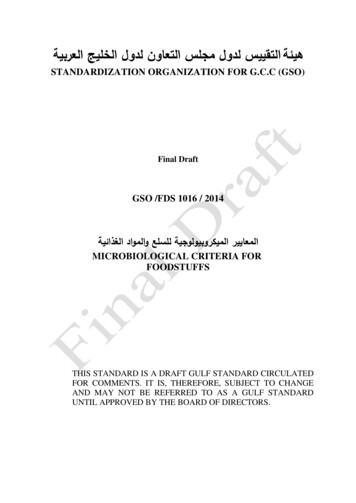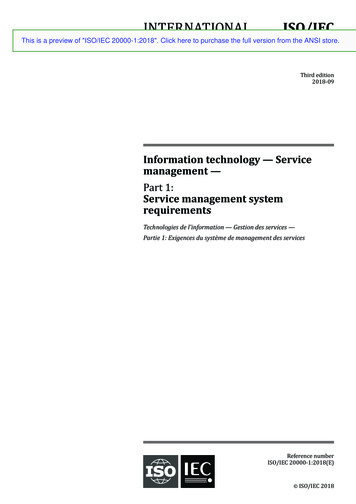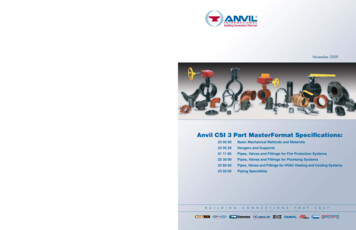
Transcription
هيئة التقييس لدول مجمس التعاون لدول الخميج العربية STANDARDIZATION ORGANIZATION FOR G.C.C (GSO)Final DraftGSO /FDS 1016 / 2014 المعايير الميكروبيولوجية لمسمع والمواد الغذائية MICROBIOLOGICAL CRITERIA FORFOODSTUFFSTHIS STANDARD IS A DRAFT GULF STANDARD CIRCULATEDFOR COMMENTS. IT IS, THEREFORE, SUBJECT TO CHANGEAND MAY NOT BE REFERRED TO AS A GULF STANDARDUNTIL APPROVED BY THE BOARD OF DIRECTORS.
MICROBIOLOGICAL CRITERIA FORFOODSTUFFSDate of GSO Board of Directors' Approval :Issuing Status:Technical Regulation
ForewordGCC Standardization Organization (GSO) is a regional Organization whichconsists of the National Standards Bodies of GCC member States. One of GSOmain functions is to issue Gulf Standards/Technical regulations throughspecialized technical committees (TCs).GSO through the technical program of committee TC No. 5 "technicalcommittee for standards of food and agriculture products" has updated the GSOStandard No. (1016/1998) ''Microbiological criteria for foodstuffs – Part 1''. Thedraft standard has been prepared by State of Qatar.This standard has been approved as Gulf Technical Regulation by GSO Board ofDirectors in its meeting No./.held on / / / H, / / G. The approvedstandard will replace and supersede the standard No.(GSO 1016/1998).i
CONTENTSPageFOREWORD .iCONTENTS . iiPREFACE . 11. SCOPE . 22. COMPLEMENTARY REFERENCES . . 23. DEFINITIONS . 23.1 Microbiological criteria . 23.2 Lot . 23.3 Sampling plan . 23.3.1 Two-class attributes plan . 33.3.2 Three-class attributes plan . 33.4 Defect sample . 33.5 Marginally acceptable . 34. REQUIREMENTS .35. CRITERIA FOR TECHNICAL CONFORMITY. 3MICROBIOLOGICAL CRITERIA FOR FOODS AND FOOD INGREDIENTS: .41.Dairy Products .42.Infants, Children and Certain Categories of Dietetic Foods .63.Meat, Poultry and their Products .84.Fish and Shellfish and their Products .105.Egg and Egg Products .116.Fats and Oils .127.Tomato Concentrates, Sauces, Vinegar, Spices and Herbs . .138.Canned Foods and Ingredients for Canning . 14ii
GSO STANDARDGSO 1016/20149.Cereals, Legumes and their Products .1610.Fruits and Vegetables.1811.Jelly, Jam and Marmalade . 1912.Chocolates, Sweets and their Ingredients .2013.Ingredients for Food Industries . 2114.Drinking Water .2215.Beverages . 2316.Ready to Eat Foods .2417.Miscellaneous Foods . .26iii
PREFACEThis GSO technical regulation is concerned with the microbiological criteria for foodstuffsand for some food ingredients used as raw materials in food processing. These limits arebased on those proposed by the international commission of microbiological specifications forfoods (ICMSF) and the international standards in the field of food safety and quality.Components of microbiological criterion in particular food are chosen according to thefollowing factors:1)The seriousness of the type of health hazard on consuming a contaminated food.2)Available information on treatments the food products was subjected to, and theconditions of its handling and storage expected.3)Type of changes or spoilage to the foodstuffs.4)The environmental conditions within which the food product was produced orcirculated.5)The category or categories of consumers concerned.These limits were formulated in the form of a system known as working of sample, includinglevels of acceptance and the number of samples to be analyzed. These criteria showstringency according to the type of food product, and the purpose for which it is used; forinstance, the food products intended for consumer groups with increased susceptibility e.g.children, infants, aged people, or dietetic foods and relief foods, such as low sugar and low fatfoods. In such cases the microbial sampling plans employed are more stringent.Precautions are being taken that these limits be within attainable limits in production units byfollowing good manufacturing practice (GMP). This standard of microbiological quality willhave to be followed for any food product irrespective of any specific parameters mentioned inany other standards of specific food product, i.e. any standard specific to any product shouldcomply with the limits stipulated in this standard with respect to microbial quality.1
MICROBIOLOGICAL CRITERIA FORFOODSTUFFS1.SCOPEThis GSO technical regulation is concerned with microbiological limits for somefoodstuffs intended for human consumption and for some food ingredients used infood industry.2.2.12.22.3COMPLEMENTARY REFERENCESGSO 261 Microbiological methods of food examination - Part 1: Preparation ofsamplesGSO 1373 Microbiological methods for testing of foods Part 2: Direct microscopiccount.GSO 590 Microbiological methods of food examination Part 3: Commercial sterilitytest for canned food.2.4GSO 810 Microbiology- General guidance for microbiological examinations.2.5GSO CAC/GL 63 Principles and guidelines for the conduct of microbiological riskmanagement (MRM).2.6GSO ISO 19458 Water quality- Sampling for microbiological analysis.2.7Refer to GSO standards test methods for the microbiological analysis in foodproducts.3.DEFINITIONS3.1 Microbiological criteriaA criterion defining the acceptability of a product, a batch of foodstuffs or a process,based on the absence, presence or number of microorganisms, and/or on the quantityof their toxins/ metabolites, per unit(s) of mass, volume, area or batch.3.2 LotA definitive quantity of a commodity produced essentially under the same conditions.3.3 Sampling planA statement specifying the microbiological criteria for acceptance or rejection ofthe sample depending on the examination of a sufficient number of sample unitsvia particular analytical methods. It comprises the following:n Number of sample units to be examined.c The maximum number of sample units allowed to have a microbiologicalcriterion value greater than ''m'' and not to exceed the value of ''M''.m The acceptable microbial level in the sample unit; which separates theacceptable quality of marginal-quality acceptance. The product shall be2
GSO STANDARDM GSO 1016/2014acceptable if the value is equal to or less than "m"; if the value is above"m", the product is marginally acceptable or rejected.The maximum criterion value that should not be exceeded in any of ''n''units.Sample unit A sample from the food product examined as one unit from ''n''. Itis either a single or a part of a package or a mixed compound of the product.3.3.1Two-class attributes planThe plan provides a simple means of inspection where the sampling plan isdefined by two values, ''n'' and ''c''. "n" is the number of sample units to beexamined to meet the plan's requirements. "c" is the maximum number of thedefective sample units. "m" for microbial criteria to identify defects. For example;inspection of the presence of Salmonella in 25 g of fresh vegetables; should not bedetected in ten sample units (n 10, c 0, m 0).3.3.2Three-class attributes planThe plan attributes are defined by the values "n", "c", "m" and "M". "m" is theminimum acceptable value of microorganism in the examined units. "M"differentiates between samples minimally acceptable of the defective units. Forexample; the number of colony forming unit (CFU) of any of the five sample unitstested must not exceed 106 and not more than 3 104 from three or more of the fivesamples tested (n 5, c 2, m 3 104, M 106).3.4Defect sampleThe Sample unit that gives a microbiological criterion value higher than the valueof ''M''.3.5Marginally acceptableSample units have a microbial count higher than ''m'' but not more than ''M''.4.4.15.REQUIREMENTSMicrobiological criteria for foodstuffs and food ingredients shall be as indicatedagainst each in the table.CRITERIA OF TECHNICAL CONFORMITY5.1Samples are considered unacceptable in the following cases:5.1.1When the microbiological criterion value exceeds ''M'' in one or more sampleunits ''n''.5.1.2If the number of marginally acceptable samples is higher than c value set in thesampling plan.3
GSO STANDARDGSO 1016/2014Microbiological criteria for foods and food ingredients1. Dairy ProductsItemPasteurized milk(with or without addedflavour)UHT milk(with or without addedflavour)Fermented milk products(with or without addedflavour), e.g. yoghurt,laban, labenaCondensed and sweetencondensed �–––––Evaporated milkPasteurized cream (withor without addedflavour)Whipped creamFermented robic plate countEnterobacteriaceaeEscherichia coliSalmonellaIncubation at 37 oC/15days or 55 oC/7days:Aerobic plate countEnterobacteriaceaeSalmonella*Yeasts and mouldsEnterobacteriaceaeEscherichia coliSalmonella*Staphylococcus aureusAerobic plate countEnterobacteriaceaeStaphylococcus aureusRequirements for cannedappliedAerobic plate countYeasts and mouldsEnterobacteriaceaeEscherichia coliSalmonella*Aerobic plate countEnterobacteriaceaeEscherichia coliSalmonellaStaphylococcus aureusYeasts and mouldsEnterobacteriaceaeEscherichia coliStaphylococcus aureusOnly in the case of added flavour.4n5555Limit per ml or roducts (Item 8) shall 10101001010510220––5x10520––10210220–102
GSO STANDARDItemSterilized creamPowdered milk(skimmed, semiskimmed), whey (driedor powdered condensed)Powdered whippedcream (with or withoutadded flavourSoft cheese (made frompasteurized milk)Hard and semi–hardcheeseProcessed cheese packedin non-metal containersCaseinateEdible ices(Ice cream (with nut*)–ice milk –water ice)Dehydrated ice creammixesMilkshakesGSO 1016/2014MicroorganismsLimit per ml or gramncmMRequirements for canned products (Item 8) shall be ––––––––––––Aerobic plate countEnterobacteriaceaeEscherichia coliSalmonellaStaphylococcus aureusAerobic plate countYeasts and mouldsEscherichia coliSalmonellaEnterobacteriaceaeEscherichia coliSalmonellaListeria monocytogenesStaphylococcus aureusEnterobacteriaceaeEscherichia coliSalmonellaListeria monocytogenesStaphylococcus aureusAerobic plate countEnterobacteriaceaeEscherichia coliSalmonellaListeria monocytogenesStaphylococcus aureusAerobic plate countEnterobacteriaceaeEscherichia coliSalmonellaStaphylococcus aureusAerobic plate countMoulds*EnterobacteriaceaeEscherichia coliSalmonellaStaphylococcus aureusAerobic plate countEnterobacteriaceaeEscherichia coliSalmonellaColiformsSalmonellaStaphylococcus aureus* In case of ice cream containing 2––10–102
GSO STANDARD2.GSO 1016/2014Infants, Children and Certain Categories of Dietetic FoodsItemBiscuits (plain, dried)Shelf–stable driedbiscuits coated orfilled with chocolateor othersDried and instantproducts eaeYeasts and mouldsSalmonellaEscherichia coli O157Staphylococcus aureusBacillus cereusEnterobacteriaceaeSalmonellaEscherichia coli O157Staphylococcus aureusBacillus cereusAerobic plate countEnterobacteriaceaeSalmonellaEscherichia coli O157**CronobactersakazakiiLimit per ml or 02–––52102103(infant food 6 months andyounger)–––Cereal based foods for–infant–––––Powdered infant–formula, including those –withlacticacid- –producing culturesStaphylococcus aureusBacillus cereus***Clostridium perfringens****Aerobic plate count*SalmonellaStaphylococcus aureusBacillus cereusListeria monocytogenesClostridium sakazakii–––––––––Staphylococcus aureusBacillus cereusListeria monocytogenesClostridium perfringensAerobic plate countEnterobacteriaceaeEscherichia coliSalmonellaCronobactersakazakiiDried productsrequiring heating toboiling beforeconsumption(infant food 6 months andyounger)(infant food 6 months andyounger)–Bacillus cereus***6
GSO STANDARDGSO 1016/2014ItemMicroorganismsLimit per ml or gramncmM– Clostridium perfringens**** 5210102processed Shall meet the microbiological requirements for canned foodsinsealed specified in this standard (8)ThermallyproductscontainersDietetic foods to beeaten by high riskcategory of consumers(according to the typeof the product)Body building Aerobic plate countEscherichia coliSalmonellaEscherichia coli O157****Campylobacter jejuni/25 gListeria monocytogenesStaphylococcus aureusBacillus cereusClostridium perfringensAerobic plate countYeasts and mouldsColiformsEscherichia coliSalmonellaStaphylococcus �––* 10 samples for infant younger than 6 months, 5 samples for infants older than 6 months** Optional*** In case of the product contains milk and/or rice**** In case of the products contains meat7
GSO STANDARD3.GSO 1016/2014Meat, Poultry and its Products–––Aerobic plate countSalmonellaEscherichia coli O157Limit per gram or ��––––––Aerobic plate countSalmonella**Campylobacter jejuni***Aerobic plate count****EnterobacteriaceaeSalmonellaEscherichia coli O157Staphylococcus aureus***Clostridium perfringens*****Aerobic plate countSalmonellaEscherichia coli O157Staphylococcus aureusClostridium 103103107––103103––Aerobic plate countSalmonella55201050106–Aerobic plate countSalmonellaEscherichia coli O157Listeria monocytogenesStaphylococcus aureusBacillus cereusClostridium perfringensAerobic plate countSalmonellaCampylobacter jejuniListeria monocytogenesStaphylococcus aureusBacillus cereusClostridium 3105–––104103103ItemRaw meat(chilled/frozen); wholeor half carcasses; pieceswith or without bonesFresh poultry (chilled/frozen)Raw minced (meat andpoultry);chilled/frozenRaw minced/piecesmeat (chilled/ frozen)with soy or marinated(e.g. kubba; meat balls,fresh sausage, meatburgers)Raw edible offal(chilled/frozen) e.g. livertestes, kidney, gizzardCured and/or smokedmeat; mortadella;luncheon red and/or smoked–poultry meat; mortadella, –frankfurters, turkey,–smoked turkey breast––––2*Limit per cm in case of red meat only** Sample is rejected if the sample unit is positive to Salmonella typhimurium andSalmonella enteritidis test.*** In case of chilled minced meat and chilled poultry.**** This criterion shall not apply to minced meat produced at retail level when the shelf-lifeof the product is less than 24 hours.***** Optional.8
GSO STANDARDItemGSO 1016/2014Microorganisms– Aerobic plate count– Salmonella– Staphylococcus aureus– Clostridium perfringensCooked poultry meat,– Aerobic plate countfrozen to be reheated– Salmonellabefore eating (e.g.– Campylobacter jejuni*prepared frozen meals;– Escherichia coli O157chicken burgers;– Listeria monocytogeneschicken/ turkey rolls,– Staphylococcus aureuschicken nuggets, others– Bacillus cereus*breaded poultry products – Clostridium perfringens*Meat & poultry soup– Aerobic plate count(concentrated, powder)– Enterobacteriaceae– Salmonella– Bacillus cereus**– Clostridium perfringensDehydrated meat or meat – Salmonellacomponents; protein– Listeria monocytogenes*concentrates from meat– Staphylococcus aureus– Clostridium perfringensVacuum packed-semi– Aerobic plate countpreserved but perishable – Salmonellameat and poultry– Campylobacter jejuniproducts– Staphylococcus aureus– Clostridium perfringensCooked sausagesLimit per ml or 1035210210365210107500–500–521021035210102* Optional** In case of products containing rice or corn flour as ingredient.9
GSO STANDARD4.GSO 1016/2014Fish and Shellfish their ProductsItemRaw fish and itsproducts (chilled/frozen)e.g.fishblocks,comminuted,minced, and slicedRaw (chilled/ frozen)crustaceans (e.g. shrimp,prawns, lobsters andcrab)Live mollusks such asbivalve (oysters, clams,mussels, etc.),cephalopods (squids,cuttlefish, octopus, etc.),gastropods (snails, etc.)Frozen/chilled breadedfish, crustaceans andmollusks products(e.g. fish sticks (fingers),fish protein, and fishcakes)Smoked fish includingherring, cooked prior toeating and eatenuncookedDried sea food,dehydrated fish and fishproteinSalted and/or fermentedfishCooked (chilled/ frozen)crustaceans, molluscansMicroorganisms–––n555Limit per gram or ��–––Aerobic plate countEscherichia coliVibrioparahaemolyticusClostridium botulinumAeromonas spp.Aerobic plate countEscherichia coliSalmonellaV. parahaemolyticusListeria monocytogenesStaphylococcus aureusEscherichia coliSalmonellaV.parahaemolyticus ––Aerobic plate countEscherichia coliSalmonella*V. parahaemolyticusStaphylococcus �–––––Aerobic plate countEscherichia coliV. parahaemolyticusListeria monocytogenesStaphylococcus aureusAerobic plate countYeasts and mouldsSalmonellaStaphylococcus aureusClostridium perfringensAerobic plate countEscherichia coliEscherichia coli O157SalmonellaV. parahaemolyticusStaphylococcus aureusClostridium perfringensAerobic plate countEscherichia coliSalmonellaV. parahaemolyticusListeria monocytogenesStaphylococcus 10201021065x102103–104106104–1031031064 102–––1021041065x102–103–103* Optional10
GSO STANDARD5.GSO 1016/2014Egg and Egg ProductsItemFresh whole eggsLiquid pasteurised egg(whole, yolk or white),chilled or frozenAny egg product intendedfor special dietarypurposes (infants, aged,relief foods, etc.)Pudding with egg(powders)Egg mix dehydratedDried cake mixes withhigh egg terobacteriaceaeSalmonellaCampylobacter jejuniAerobic plate countEnterobacteriaceaeSalmonellaCampylobacter jejuniAerobic plate countEnterobacteriaceaeSalmonellaLimit per ml or –––––––––Aerobic plate countEnterobacteriaceaeEscherichia coliSalmonellaListeria monocytogenesStaphylococcus aureusBacillus cereusClostridium perfringensAerobic plate countEnterobacteriaceaeEscherichia coliSalmonellaStaphylococcus aureusEnterobacteriaceaeSalmonellaStaphylococcus aureusBacillus 2105102–––102–103–
GSO STANDARD6.GSO 1016/2014Fats and OilsItemButter (Salted andUnsalted)Ghee (Butter oil)Fats from milkMargarineAll kinds of Nut �–––––––––––Lipolytic bacteriaEnterobacteriaceaeYeasts and mouldsEscherichia coliSalmonellaListeria monocytogenesStaphylococcus aureusEnterobacteriaceaeYeasts and mouldsSalmonellaStaphylococcus aureusAerobic plate countYeasts and mouldsEscherichia coliSalmonellaListeria monocytogenesStaphylococcus aureusAerobic plate countMouldsEnterobacteriaceaeSalmonella12Limit per ml or –500–500–352101041525x10 5x10252101021000–
GSO STANDARD7.GSO 1016/2014Tomato Concentrates, Sauces, Vinegar, Spices and HerbsItemLimit per ml or gramncmMcanned Requirements for canned products (Item 8) shall be appliedAll kinds oftomato productsAll kinds of tomatoproductsMayonnaise, mustard,salad sauce and othersaucesVinegarDried herbs and Spices,ready to eat herbs andspicesDried herbs (roselle,camomile, others)All types of teaCoffee and Salmonella*Aerobic plate countYeasts and mouldsEnterobacteriaceaeEscherichia coliSalmonellaStaphylococcus aureusAerobic plate countAerobic plate countMouldsFaecal ColiformsSalmonellaStaphylococcus aureusBacillus cereusClostridium perfringensAerobic plate countAnerobic plate countYeasts and mouldsColiformsColiformsYeasts and 06106102–103104103104103102104102103102
GSO STANDARD8.GSO 1016/2014Canned Foods and Ingredients for CanningCommercially sterilized canned foods shall pass sterility test described in GSO590/1995 ''Microbiological Methods of Foods Examination – Commercial SterilityTest for Canned Food'', in accordance with the following procedure:ItemMicroorganismsLimit per ml or gramncmM24–0–First Action– Must be the number of canstested 24 cans and the absence ofdefects; lock; welding orswellingduringincubationindicates the efficiency of thecommercial sterilization processand the safety of batchproduction.Second Action– When there are 1-2 defectivecans or swelling should;therefore larger numbers of cansshould be sorted from the batch.– In case of presence of more than1 % of defective cans; reject thebatch, but the presence of 1 % orless; the third action is taken.–1%0–Third Action– Examine 24 cans during theincubation period for not lessthan 10 days in the incubator at atemperature of 30-37 C for nonacid canned, or in the incubatorat 25 C for acidic canned.– Production is not identical inthe case of a can or moredefective or welding or swellingafter incubation.2400–Fourth Action– Being in the absence of anyswelling or defects lock andwelding after the third action.– Open and lifting the welding andexamine 10 cans.– Accept the batch in the absenceof any defects in the weld orlock.1000–14
GSO STANDARDGSO 1016/2014* Food products being used in the manufacture of canned food:Flour - milk - sugars - pectin - acids - beans - starch – cereals by productsMicroorganismsnThermophilic bacteria:1234-Limit per ml or gramcm5 units must be examined; 10 g eachAerobicFlat- sour bacteriaAnaerobic non H2S producingAnaerobic H2S producing555515125/10 g 150/10 g50/10 g75/10 g3 samples negatives4 samples negativesM
GSO STANDARD9.GSO 1016/2014Cereals; Legumes and their ProductsItemCereal grainsCereals, cereal flours andby-products such as branSoya flours, concentratesand isolatesStarch and starchcontaining products(e.g. custard powder)Pasta / Macaroni &Noodles (uncooked, wet& dry) with or withoutfillingPizza, meat pies, frozendough with or withoutfillingBreadSpecial breads(sweetened) with egg, ormilkCakes and bakeryproducts (ready to eat)Puffed, flaked ��–––––––––––––Limit per ml or 01035220102––MouldsSalmonellaMouldsBacillus cereusClostridium perfringensMouldsEscherichia coliSalmonellaBacillus cereusAerobic plate count*Yeasts and mouldsSalmonellaStaphylococcus aureusBacillus cereusClostridium perfringensColiforms*Yeasts and mouldsEscherichia coliSalmonellaBacillus ococcus �––––––––Yeast and mouldsEnterobacteriaceaeYeasts and mouldsEnterobacteriaceaeSalmonellaStaphylococcus aureusAerobic plate countEnterobacteriaceaeEscherichia coliSalmonellaListeria monocytogenes*Staphylococcus aureusBacillus cereusAerobic plate countMouldsSalmonellaBacillus cereusClostridium 02–102105103–––102–105104–105–* Optional16
GSO STANDARDGSO 1016/2014ItemEntrees (soup) containingrice or corn flour as mainingredient(frozenordried)Cakes, desserts andbakery products (frozen ordehydrated)Malt, Malt derivativesMicroorganisms–Bacillus cereusLimit per ml or gramncmM51103104––––––––Aerobic plate countEscherichia coliSalmonellaStaphylococcus aureusAerobic plate countYeasts and mouldsSalmonellaStaphylococcus �1021055x103–103
GSO STANDARD10.GSO 1016/2014Fruit and VegetablesItemMicroorganismsFresh fruits and vegetables – Escherichia coli(precut and crudités)– Salmonellato be consumed raw– Escherichia coli O157– Listeria monocytogenes– Staphylococcus aureusDried vegetables– Escherichia coliDried fruits; dates(including date paste),figs, apricot, grape(raisons), etc)Frozen vegetables andfrozen fruits, pH equalor higher than 4.5Frozen vegetables andfrozen fruits, pH lessthan 4.5Vegetable soup (powder)Pickled/Fermentedvegetable/Fruits (e.g.sauerkraut, pickles, tableolive, etc.)Fried potatoes (e.g. chips,fingers, etc.)Concentrated tamarindn555555Limit per ml or uldsEscherichia coliSalmonella55552220101020010210310–– Escherichia coli52102103––––pH measured at the time of pH values shall be less thansampling4.5 in all tested samples– Aerobic plate count– Yeasts and Moulds– Escherichia coli– Salmonella– Bacillus cereus– Clostridium perfringens– Yeasts– 1041032–– Aerobic plate count– Salmonella– Bacillus cereus– Clostridium perfringens– Moulds– Escherichia coli5555551010005x1040104000105–105–––18
GSO STANDARD11.GSO 1016/2014Jelly, Jam and MarmaladeItemMicroorganismsnJam, jelly and marmalade–Jelly powder– SalmonellaFruit whole/pieces insugar syrup (canned)Yeasts and mouldsLimit per ml or gramcmM51103104500–Requirements for canned products (Item 8) shall be applied19
GSO STANDARD12.GSO 1016/2014Chocolate, Sweets and their IngredientsItemChocolate (plain orsweetened- with milk, orfilled or covered withnuts), toffee, nougat,fudge etc.Dehydrated desserts,(bonbons, caramels andother similar products)Hard & soft candyCocoaCoconut(grated/desiccated)NutsChewing gumHoneyArabic sweetsMolasses, debs (datesyrup), hard brown sugarConcentrated cane syrupMicroorganisms–––Aerobic plate �––––––––––––––Aerobic plate countEscherichia coliSalmonellaStaphylococcus aureusAerobic plate countYeasts and mouldsEnterobacteriaceaeSalmonellaYeasts and eriaceaeSalmonellaMouldsEscherichia coliYeasts and mouldsSalmonellaYeasts and mouldsSulphite-reducinganaerobesClostridium botulinum*ColiformsSalmonellaEscherichia coli O157Listeria monocytogenes*Staphylococcus aureusYeasts and mouldsEscherichia coliSalmonellaYeasts and mouldsEscherichia * Optional20Limit per ml or 10200–00––––––10310–10––
GSO STANDARD13.GSO 1016/2014Ingredients for Food IndustriesItemMicroorganismsnLimit per ml or gramcmMEnzymes––Escherichia coliSalmonella510200010–Dyes (food col
UHT milk- - Incubation at 37 oC/15 (with or without added days or 55 oC/7days: flavour) - Aerobic plate count 5 0 10 - - Enterobacteriaceae 5 0 0 - - Salmonella* 10 0 0 - Fermented milk products - Yeasts and moulds 5 1 10 102 (with or without added - Enterobacteriaceae 5 1 5 10











